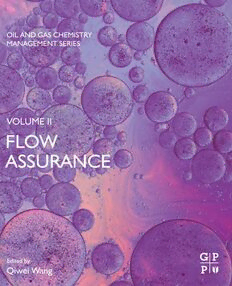Table Of ContentFlow Assurance
This pageintentionallyleftblank
Oil and Gas Chemistry Management Series
Flow Assurance
Volume II
Edited by
Qiwei Wang
Saudi Aramco, Dhahran, Saudi Arabia
GulfProfessionalPublishingisanimprintofElsevier
50HampshireStreet,5thFloor,Cambridge,MA02139,UnitedStates
TheBoulevard,LangfordLane,Kidlington,Oxford,OX51GB,UnitedKingdom
Copyright©2022ElsevierInc.Allrightsreserved.
Nopartofthispublicationmaybereproducedortransmittedinanyformorbyanymeans,electronic
ormechanical,includingphotocopying,recording,oranyinformationstorageandretrievalsystem,
withoutpermissioninwritingfromthepublisher.Detailsonhowtoseekpermission,further
informationaboutthePublisher’spermissionspoliciesandourarrangementswithorganizationssuch
astheCopyrightClearanceCenterandtheCopyrightLicensingAgency,canbefoundatourwebsite:
www.elsevier.com/permissions.
Thisbookandtheindividualcontributionscontainedinitareprotectedundercopyrightbythe
Publisher(otherthanasmaybenotedherein).
Notices
Knowledgeandbestpracticeinthisfieldareconstantlychanging.Asnewresearchandexperience
broadenourunderstanding,changesinresearchmethods,professionalpractices,ormedical
treatmentmaybecomenecessary.
Practitionersandresearchersmustalwaysrelyontheirownexperienceandknowledgeinevaluating
andusinganyinformation,methods,compounds,orexperimentsdescribedherein.Inusingsuch
informationormethodstheyshouldbemindfuloftheirownsafetyandthesafetyofothers,including
partiesforwhomtheyhaveaprofessionalresponsibility.
Tothefullestextentofthelaw,neitherthePublishernortheauthors,contributors,oreditors,assume
anyliabilityforanyinjuryand/ordamagetopersonsorpropertyasamatterofproductsliability,
negligenceorotherwise,orfromanyuseoroperationofanymethods,products,instructions,orideas
containedinthematerialherein.
ISBN:978-0-12-822010-8
ForInformationonallGulfProfessionalPublishingpublications
visitourwebsiteathttps://www.elsevier.com/books-and-journals
Publisher:CharlotteCockle
SeniorAcquisitionsEditor:KatieHammon
SeniorEditorialProjectManager:SaraValentino
ProductionProjectManager:SojanP.Pazhayattil
CoverDesigner:MilesHitchen
TypesetbyMPSLimited,Chennai,India
Contents
List ofcontributors..................................................................................................xv
CHAPTER 1 Gas hydrate management.............................................1
Gaurav Bhatnagarand Shawn Gao
1.1 Introduction....................................................................................2
1.2 Fundamentals ofhydrate................................................................3
1.2.1 Definition............................................................................3
1.2.2 Structures.............................................................................3
1.2.3 Phase behavior....................................................................6
1.2.4 Properties.............................................................................8
1.3 Hydrateformation........................................................................10
1.3.1 Hydrate formationscenarios.............................................10
1.3.2 Hydrate formationmechanism.........................................10
1.4 Hydratemanagement inproduction systems...............................11
1.4.1 Risk assessment.................................................................12
1.4.2 Hydrate modeling..............................................................12
1.5 Temperature control.....................................................................27
1.5.1 Thermal insulation............................................................27
1.5.2 Active heating...................................................................32
1.6 Chemicalinhibition......................................................................36
1.6.1 Thermodynamichydrate inhibitors...................................36
1.6.2 Low-dosagehydrate inhibitors.........................................40
1.7 Dehydration..................................................................................64
1.8 Hydrateremediation.....................................................................66
1.8.1 Depressurization................................................................66
1.8.2 Heating..............................................................................67
1.8.3 Chemical dissociation.......................................................68
1.8.4 Model predictionsfor remediation...................................69
1.9 Case studies..................................................................................69
1.9.1 Hydrate management indrytree facilityfacilities..........69
1.9.2 Low-dosagehydrate inhibitor field application...............72
1.9.3 Tommeliten-gamma field.................................................73
1.9.4 RemediationofhydratepluginwestAfricadeepwater
floatingproductionstorageandoffloading............................75
1.10 Summary.......................................................................................77
Nomenclature...............................................................................77
References....................................................................................78
v
vi Contents
CHAPTER 2 Paraffin management..................................................85
MikeNewberry and David W.Jennings
2.1 Historyof paraffin management developments..........................85
2.2 Crude oil andparaffinchemistry.................................................88
2.3 Paraffinanalysis andcrude oilcharacterization..........................91
2.3.1 Paraffin analysismethods.................................................91
2.3.2 Crude oil characterization.................................................93
2.4 Paraffindeposition.....................................................................103
2.4.1 Paraffin depositionmechanisms.....................................103
2.4.2 Paraffin depositionmodeling..........................................106
2.4.3 Paraffin deposit characteristics.......................................111
2.4.4 Paraffin depositioncontrol..............................................114
2.5 Pour point/crude oil gelling problems.......................................153
2.5.1 Crude oil gellingmechanism..........................................153
2.5.2 Gelled flowlinecharacteristics.......................................155
2.5.3 Pourpoint treatment........................................................156
2.6 Case histories..............................................................................165
2.6.1 Formationdamage..........................................................165
2.6.2 Well tubing deposition....................................................168
2.6.3 Flowline deposition.........................................................170
2.6.4 Tank bottoms...................................................................175
2.7 Summary.....................................................................................175
Nomenclature.............................................................................176
References..................................................................................177
CHAPTER 3 Asphaltene management...........................................185
Priyanka Juyal and Andrew TYen
3.1 Introduction................................................................................186
3.2 Chemistryof asphaltenes...........................................................186
3.2.1 Composition and structure..............................................186
3.2.2 Solubilityand aggregation..............................................188
3.3 Experimentaltechniquesforasphaltenestabilityprediction.........191
3.3.1 Solids detection system...................................................191
3.3.2 DeBoer plot.....................................................................192
3.3.3 Dead oil tests...................................................................192
3.4 Asphaltene stability modeling....................................................194
3.4.1 Asphaltene instabilitytrend modeling............................194
3.4.2 Asphaltene deposition model..........................................195
3.5 Asphaltene inhibitor lab tests.....................................................198
3.5.1 Precipitation tests............................................................199
Contents vii
3.5.2 Deposition tests...............................................................201
3.5.3 Live oil tests....................................................................207
3.6 Asphaltene control inoil production.........................................211
3.6.1 Prevention........................................................................211
3.6.2 Remediation....................................................................213
3.7 Case studies................................................................................213
3.7.1 Labscreening methods for fieldapplications................213
3.7.2 Evaluating asphaltene inhibitorsfor anoffshore
alaskan producer.............................................................214
3.7.3 Developmentofmultifunctional stabilizers of
asphaltenes......................................................................215
3.8 Conclusion and path forward.....................................................215
Acknowledgment.......................................................................217
Nomenclature.............................................................................217
References..................................................................................218
CHAPTER 4 Naphthenate and carboxylate soap treatment.........227
Jonathan J. Wylde
4.1 Introduction................................................................................228
4.1.1 Overview and chapter orientation..................................228
4.1.2 Naphthenatesand recent history.....................................228
4.1.3 Definitions: acid crude oil and“naphthenates”..............231
4.1.4 Originofacidic crude.....................................................234
4.1.5 Carboxylate and naphthenate soap operational
challenges........................................................................235
4.1.6 Thecontinuum model.....................................................237
4.2 Fouling mechanisms ofnaphthenate andcarboxylate
soaps...........................................................................................238
4.2.1 Analytical techniques for acidic species in
crude oils.........................................................................238
4.2.2 Soapemulsions...............................................................244
4.2.3 Naphthenatesoap solids..................................................252
4.2.4 Highcalcium incrude caused by oil-dispersible
naphthenates....................................................................259
4.2.5 Refinery challenges overview.........................................262
4.3 Chemicalcontrol methodologies and laboratory testing...........263
4.3.1 Introduction.....................................................................263
4.3.2 Preventive chemical strategies........................................264
4.3.3 Remediationand remedial chemical strategies..............270
4.3.4 Laboratory and field testing............................................271
4.4 Concluding remarksand remaining challenges.........................272
viii Contents
Nomenclature.............................................................................273
Acknowledgments.....................................................................274
References..................................................................................274
CHAPTER 5 Inorganic mineral scale mitigation..........................287
Gordon Michael Grahamand DarioMarcello Frigo
5.1 Introduction................................................................................288
5.1.1 The roleof water.............................................................289
5.1.2 Inorganicmineral scalingin the oil environment..........291
5.2 Basic principles ofinorganic scale formation...........................293
5.2.1 Types of inorganicmineral scale...................................293
5.2.2 Inorganicmineral scale formation..................................298
5.2.3 Scale nucleation andgrowth...........................................305
5.2.4 Thermodynamics andkinetics........................................309
5.3 Scaleprediction..........................................................................311
5.3.1 Scale prediction asa component of scale
management....................................................................311
5.3.2 Scale prediction outputs..................................................312
5.3.3 Theory of scale prediction..............................................315
5.3.4 Importance ofqualityinput data....................................319
5.3.5 Example ofthe utilityofmodern scale
prediction packages.........................................................321
5.3.6 Limitations ofscale prediction.......................................322
5.4 Scalecontrol...............................................................................323
5.4.1 Treatment options and scale control strategies..............323
5.4.2 Chemicalinhibition.........................................................330
5.4.3 Types of scale inhibitors commonlyused inoil
industry............................................................................334
5.4.4 Brief history ofscaleinhibitor development..................341
5.4.5 Chemicaldeployment.....................................................342
5.4.6 Chemicalinhibition.........................................................344
5.4.7 Factors controlling the performance of
genericallydifferent inhibitor chemistries.....................348
5.4.8 Laboratoryassessment of scale inhibitors......................359
5.4.9 Chemicalqualification: final considerations..................371
5.5 Scaleinhibitor squeeze...............................................................372
5.5.1 Chemicalsqueezeprocess..............................................372
5.5.2 Chemicalretentionmechanisms.....................................381
5.5.3 Chemicaltesting of scale inhibitor squeeze
treatments:reservoircondition core flooding................387
Contents ix
5.5.4 Theimportance ofappropriate core floodtesting
protocols..........................................................................388
5.5.5 SI Application considerations: formationdamage
and inhibitor retention/release properties.......................392
5.5.6 Importance of accurate assay and monitoring................403
5.5.7 Isothermderivation and near-wellbore simulation.........406
5.6 Scale remediation.......................................................................412
5.6.1 Acid soluble vsacidinsoluble scales.............................413
5.6.2 Mechanical Remediation/Physical Methods...................414
5.6.3 Chemical dissolution.......................................................416
5.6.4 Chemical deployment inscale dissolution.....................417
5.6.5 Acids for ScaleDissolution............................................419
5.6.6 Chelating agents for scale dissolution............................422
5.7 Summary.....................................................................................426
Nomenclature.............................................................................426
References..................................................................................428
CHAPTER 6 Sand control completion using in-situ resin
consolidation.............................................................443
PhilipNguyen and Mike Sanders
6.1 Sand control................................................................................443
6.1.1 Mechanisms andcausesof sand production..................443
6.1.2 Problems/issuesof sand production...............................444
6.1.3 Sandcontrol methods......................................................444
6.1.4 Other wellbore stabilizationmethods for
sand control.....................................................................447
6.1.5 Perforating techniques for completionsusing
sand-consolidation treatments.........................................448
6.1.6 Chemical sand consolidation..........................................451
6.2 Fines Migration control..............................................................472
6.2.1 Mechanisms andcauses..................................................472
6.2.2 Previousfinesmigration control methods......................474
6.2.3 Controlling finesmigration intoproppant pack.............475
6.2.4 Fines migration field case histories................................478
6.3 Proppantflowbackcontrol.........................................................479
6.3.1 Primary proppant flowback control................................479
6.3.2 Remedial methods for proppant flowback.....................490
6.3.3 Lessons learned/recommendations.................................493
Nomenclature.............................................................................494
References..................................................................................494

